An article explains the working principle of the Wheatstone bridge
Source: InternetPublisher:同住地球村 Keywords: Wheatstone Wheatstone bridge Updated: 2025/02/07
In the world of analog electronics, we come across various signals, some of which are measured by changes in resistance, while others are measured by changes in inductance and capacitance. If we consider resistors, most industrial sensors such as temperature, strain, humidity, displacement, liquid level, etc., produce a change in resistance value with a corresponding amount of equivalent change. Therefore, signal conditioning is required for each resistor-based sensor.
For example, the simplest device we can think of is a light dependent resistor, or LDR. As the name suggests, an LDR is a common electronic component whose resistance changes depending on the amount of light falling on it.
Generally speaking, there are three types of resistance measurements:
(1) Low resistance measurement.
(2) Medium resistance measurement.
(3) High resistance measurement.
If the resistance measurement is possible from a few micro-ohms to milliohms, then it is considered as low resistance measurement. This kind of measurement is actually used for research purposes. If the measurement is from 1 ohm to a few hundred KΩ, it is usually called medium resistance measurement. Measurement of common resistors, potentiometers, thermistors, etc. fall into this category.
Very high resistance measurements are considered to be from a few megohms to greater than 100 megohms. To find intermediate values of resistance, different methods are used, but primarily the Wheatstone bridge is used.
1. What is a Wheatstone bridge?
A bridge network or circuit is one of the most popular and popular electrical tools and is often used in measuring circuits, sensor circuits, switching circuits, and also oscillators.
The Wheatstone bridge is one of the most common and simplest bridge networks/circuits and can be used to measure resistance very accurately. But usually the Wheatstone bridge is used with sensors to measure physical quantities such as temperature, pressure, strain, etc.
The Wheatstone bridge is used in applications where small changes in resistance are measured in sensors. This is used to convert the change in resistance into a change in voltage at the transducer. This bridge in combination with an operational amplifier is widely used in industry for various sensors and transducers.
For example, the resistance of a thermistor changes when the temperature changes. Similarly, the resistance of a strain gauge changes when it is subjected to pressure, force or displacement. Depending on the type of application, the Wheatstone bridge can be operated in balanced or unbalanced conditions.
The Wheatstone bridge consists of four resistors (R1, R2, R3, and R4) connected in a diamond shape with a DC power supply connected between the top and bottom points (C and D in the circuit) of the diamond and the output spanning the other two ends (A and B in the circuit).
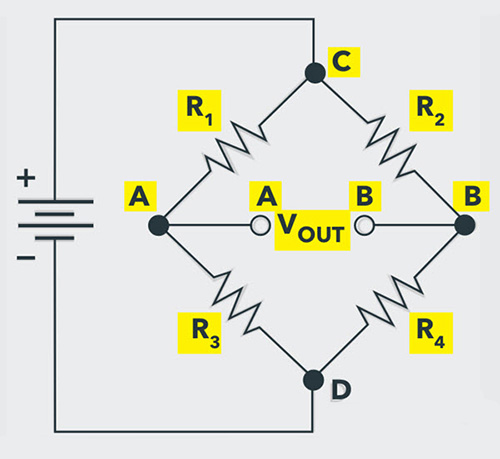
This bridge is used to find the unknown resistance very accurately by comparing it with the known resistance value. In this bridge, Null or Balanced condition is used to find the unknown resistance.
In order for the bridge to be balanced, the output voltage at points A and B must be equal to 0. From the above circuit:
A bridge is in equilibrium if:
VOUT=0V
To simplify the analysis of the above circuit, we redraw it as follows:
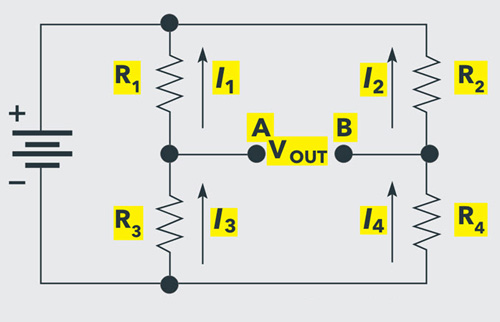
Now, for the balanced condition, the voltage across resistors R1 and R2 are equal. If V1 is the voltage across R1 and V2 is the voltage across R2, then:
V1=V2
Similarly, the voltage across resistors R3 (let's call it V3) and R4 (let's call it V4) are also equal. So,
V3=V4
The voltage ratio can be written as:
V1/V3=V2/V4
From Ohm's law, we get:
I1R1/I3R3=I2R2/I4R4
Since I1=I3 and I2=I4, we have:
R1/R3=R2/R4
From the equation above, if we know the values of three resistors, we can easily calculate the resistance of the fourth resistor.
2. Alternative Methods for Calculating Resistance
From the redrawn circuit, if VIN is the input voltage, the voltage at point A is:
VIN (R3/(R1+R3))
Similarly, the voltage at point B is:
VIN (R4/(R2+R4))
For a balanced bridge, VOUT = 0. But we know that VOUT = VA – VB.
Therefore, under the balanced bridge condition,
VA=VB
Using the equation above, we get:
VIN(R3/(R1+R3))=VIN(R4/(R2+R4))
After a simple manipulation of the above equation, we get:
R1/R3=R2/R4
From the equation above, if R1 is an unknown resistor, its value can be calculated from the known values of R2, R3, and R4. Usually, the unknown value is called RX and of the three known resistors, one resistor (mostly R3 in the above circuit) is usually a variable resistor called RV.
3. Finding Unknown Resistance Using a Balanced Wheatstone Bridge
In the above circuit, let us assume that R1 is an unknown resistor. So, let us call it RX. The resistors R2 and R4 are of fixed values. This means, the ratio R2/R4 is also fixed. Now, according to the above calculation, to create a balanced condition, the ratio of the resistors must be equal, i.e.,
RX/R3=R2/R4
Since the ratio R2/R4 is fixed, we can easily adjust another known resistor (R3) to achieve the above conditions. Therefore, it is important that R3 is a variable resistor, which we call RV.
But how do we detect the equilibrium condition? This is where a galvanometer (old fashioned ammeter) can come in handy. By placing the galvanometer between point A and point B, we can detect the equilibrium condition.
Place RX in the circuit and adjust RV until the ammeter points to 0. At this point, note the value of RV. By using the following formula, we can calculate the unknown resistance RX.
RX=RV(R2/R4)
4. Unbalanced Wheatstone Bridge
If VOUT in the above circuit is not equal to 0 (VOUT≠0), the Wheatstone is called an unbalanced Wheatstone bridge. Usually, unbalanced Wheatstone bridges are often used to measure different physical quantities, such as pressure, temperature, strain, etc.
To do this, the sensor must be resistive, meaning that the resistance of the sensor changes when the quantity it is measuring (temperature, strain, etc.) changes. Instead of the unknown resistor in the previous resistance calculation example, we can connect a sensor.
5. Wheatstone bridge for temperature measurement
Now let's see how to measure temperature using an unbalanced wheatstone bridge. The sensor we will use here is called a thermistor, which is a temperature dependent resistor. Depending on the temperature coefficient of the thermistor, a change in temperature will either increase or decrease the resistance of the thermistor.
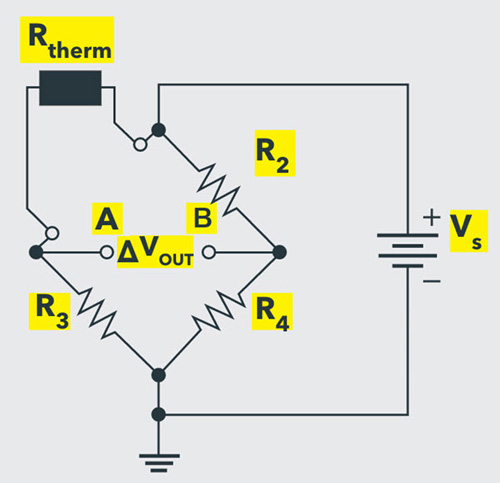
As a result, the output voltage of the bridge VOUT will become a non-zero value. This means that the output voltage VOUT is proportional to the temperature. By calibrating the voltmeter, we can display the temperature based on the output voltage.
6. Wheatstone bridge for strain measurement
One of the most common applications of the Wheatstone bridge is strain measurement. A strain gage is a device whose electrical resistance changes in proportion to a mechanical factor such as pressure, force, or strain.
Typically, strain gauge resistance ranges from 30Ω to 3000Ω. For a given strain, the resistance change may be only a small fraction of the full range. Therefore, to accurately measure fractional changes in resistance, a Wheatstone bridge configuration is used.
The circuit below shows a Wheatstone bridge with the unknown resistor replaced by a strain gauge.
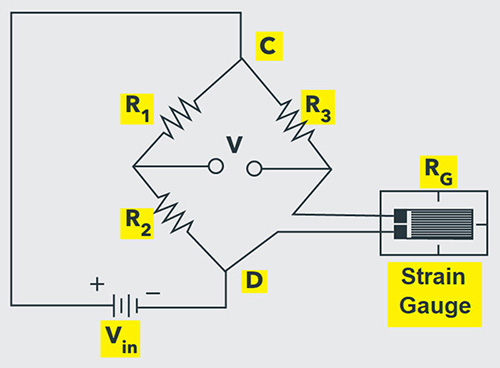
Due to the external force, the resistance of the strain gauge changes, causing the bridge to become unbalanced. The output voltage can be calibrated to show the change in strain.
A popular configuration of strain gages and Wheatstone bridges is a weight scale. In this case, the strain gages are carefully mounted as a single unit called a load cell, which is a sensor that converts mechanical force into an electrical signal.
Typically, a weight scale consists of four load cells, two of which are strain gauges that expand or stretch when a force is applied (tension type) and two of which are compressed when a load is applied (compression type).
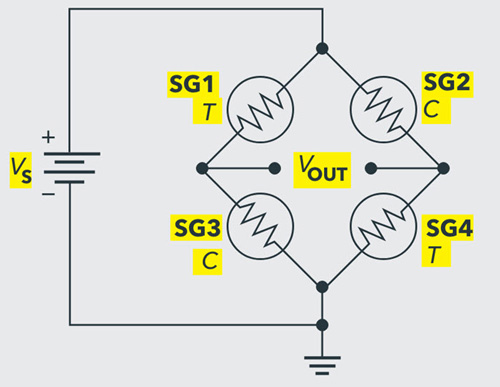
If the strain gauge is stretched or compressed, the resistance increases or decreases. Therefore, this causes an unbalance in the bridge. This produces a voltage indication on the voltmeter that corresponds to the change in strain. If the strain applied to the strain gauge is greater, the voltage difference between the meter terminals is greater. If the strain is zero, the bridge is balanced and the meter displays a zero reading.
This is about resistance measurement using a Wheatstone bridge for precise measurements. The Wheatstone bridge is mainly used for strain gage and thermometer measurements due to the fractional measurement of resistance.
7. Application of Wheatstone Bridge
(1) The Wheatstone bridge is used to accurately measure very low resistance values.
(2) The Wheatstone bridge is used together with an operational amplifier to measure physical parameters such as temperature, strain, and light.
(3) We can also use variations of the Wheatstone bridge to measure quantities of capacitance, inductance, and impedance.
- What is the function of a voltage regulator in a circuit? How to connect a voltage regulator?
- Why do we need a MOSFET gate resistor? MOSFET Gate Resistor Placement
- Which one is better, NPN or PNP transistor?
- How do Zener diodes protect circuits?
- How does sand become chips?
- What are the classifications of filters?
- Tutorial on building a NOT gate using BJT transistors
- What types of force sensors are there?
- Make a simple AM radio with digital circuit
- Common electrical circuits: frequency-selective (bandpass) amplifier circuit
- 555 square wave oscillation circuit
- 555 photo exposure timer circuit diagram
- Introducing the CD4013 washing machine timer circuit diagram
- Simple level conversion circuit diagram
- 555 electronic guide speaker circuit diagram for blind people
- Circuit diagram of disconnection alarm composed of 555
- Analog circuit corrector circuit diagram
- color discrimination circuit
- Color sensor amplification circuit
- Level indication circuit







 京公网安备 11010802033920号
京公网安备 11010802033920号